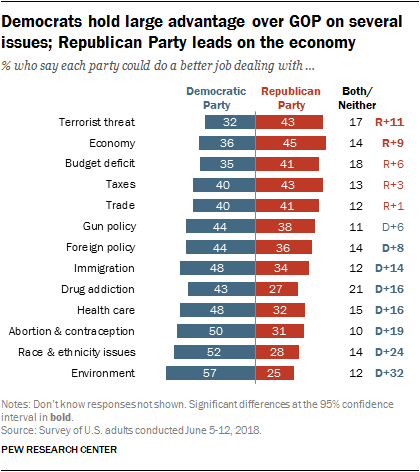
The Democratic Party holds sizable advantages over the Republican Party on a number of major issues, ranging from the environment to foreign policy, as well as immigration and health care.
But the GOP now enjoys a 9-percentage-point advantage over the Democratic Party on the economy (45% to 36%) – a significant shift from October, when neither party held an edge on economic issues.
Though the public is currently split on which party could better handle tax policy, this is also a shift from October, when the Democratic Party was preferred by a 7-point margin.
The public also is divided on other economic policy areas such as the federal budget deficit and trade agreements.
Overall, the public favors the Democratic Party over the GOP on seven other major issues. The Democratic Party advantage is particularly wide on the environment (57% say the Democratic Party could do a better job, 25% say the Republican Party) and on dealing with issues involving race and ethnicity (52% to 28%). The Democratic Party also enjoys double-digit advantages as the party better able to deal with policies on abortion and contraception (50% to 31%), health care (48% to 32%), drug addiction (43% to 27%) and immigration (48% to 34%).
The current 9-point GOP edge on dealing with the economy is the first time a party has held a clear advantage on this issue since July 2014. Four years ago, 47% of the public said the Republican Party could better handle the economy, while 39% said the Democratic Party could better handle this issue. Today, the GOP enjoys a similar advantage (45% to 36%).
Since 2014, the Democratic Party has held a significant advantage over the GOP on health care issues. Today, it is favored by 16 points. Though little different from the Democratic Party’s advantage on this issue last year, this is among the widest advantages the party has held at any point over the past eight years.
For much of the Obama administration, neither party held a significant advantage in dealing with immigration issues. By early 2017, however, the Democratic Party opened up an 11-point advantage over the GOP. Today, the Party holds a similar 14-point edge on this issue.
The Democratic Party holds an 8-point advantage as the party seen as better able to make wise decisions about U.S. foreign policy (44% to 36%). The Democrats have had a similar-sized edge on this issue since April 2017. This is a shift from years prior, when public preferences were split or the GOP had an edge.
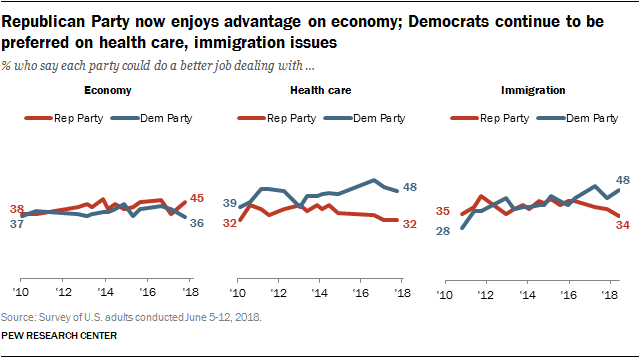
By contrast, the Republican Party is viewed by a larger share of the public as better able to deal with terrorist threats at home (43% say this, while 32% say the Democratic Party). While this is a shift since October, when the public was divided about their preferences, the current 11-point GOP edge is on par with past years.
As has been the case since 2017, views of which party could better handle trade agreements are split: 41% say the Republican Party, 40% the Democratic Party. In April 2016, the GOP had a double-digit advantage (48% to 37%) on this issue.
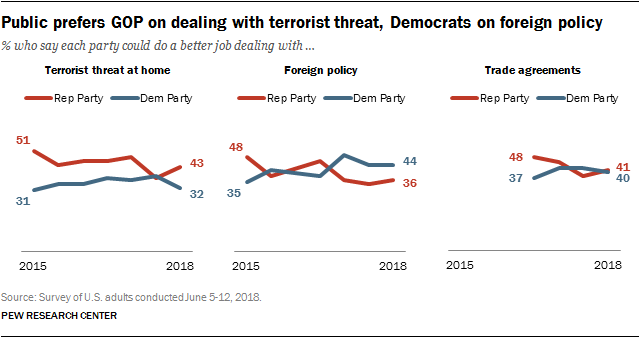
When it comes to dealing with policies on abortion and contraception, the Democratic Party continues to be preferred over the GOP by a wide margin (50% to 31%). And the preference for the Democratic Party on the environment is even wider: By a 32-point margin (57% to 25%), the public prefers the Democrats on environmental issues.
The Democratic Party now holds a narrow edge on gun policy: 44% say the Democratic Party could do a better job reflecting their views on this issue, compared with 38% who say the Republican Party could do a better job. The share of the public who says the Republican Party would be better at reflecting its views about gun policy has declined 8 points since April 2017.
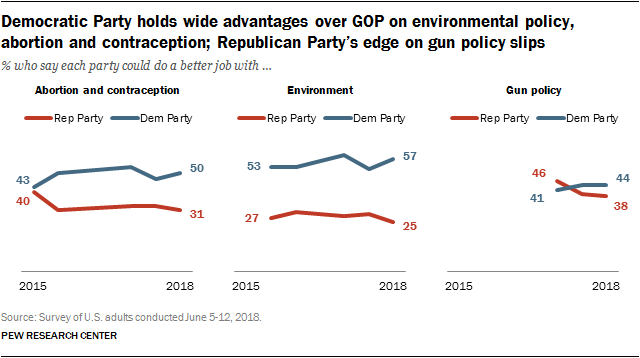
Views of congressional productivity
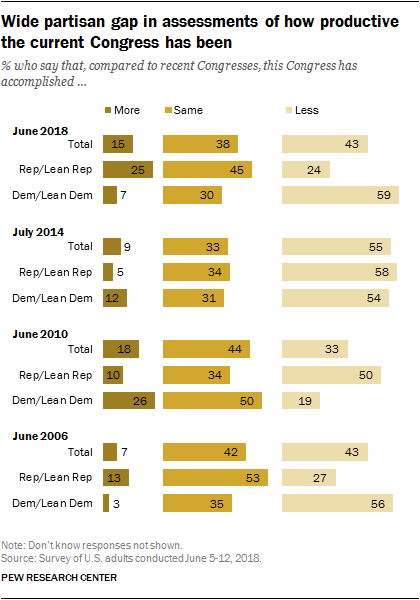
Currently, 43% of the public says that the 115th Congress has accomplished less than other recent Congresses; 38% say this Congress has accomplished about the same amount. Only 15% say this Congress has been more productive than others. The share of the public viewing Congress as productive is higher today than it was last winter (15% now, 8% then), while the share saying it has been less productive has dropped from 52% to 43%.
There are wide partisan gaps in views of congressional productivity. Only about a quarter of Republicans and Republican leaners (24%) say that the current, GOP-controlled, Congress is less productive than others. A plurality (45%) says it has accomplished about as much; a quarter say it is more productive than others.
In contrast, about six-in-ten Democrats and Democratic leaners (59%) say this Congress has been less productive compared to recent Congresses, while 30% say it has been about as productive and just 7% say it has been more productive.
This pattern is consistent with past years. In both 2006 and 2010, partisans of the party in control of Congress and the presidency offered far more positive assessments of congressional productivity than did those in the other party.
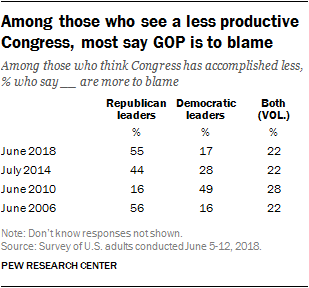
Among those who say that this Congress has accomplished less (68% of whom identify as Democrats or lean Democrat), a majority (55%) says Republican leaders are most to blame for this. Roughly a quarter (22%) say both parties’ leaders are to blame and 17% say Democratic leaders are to blame.
Among Republicans who say that the current Congress has accomplished less, 55% say Democratic leaders are to blame, while 27% say both parties’ leaders are to blame. Another 15% say their own party’s leaders are to blame.
In contrast, nearly three-quarters (73%) of Democrats who think this Congress has accomplished less say that Republican leaders are to blame. About two-in-ten (18%) say both parties’ leaders are at fault. Just 5% place the blame primarily on the Democratic leadership.
Low job approval for both parties’ congressional leaders
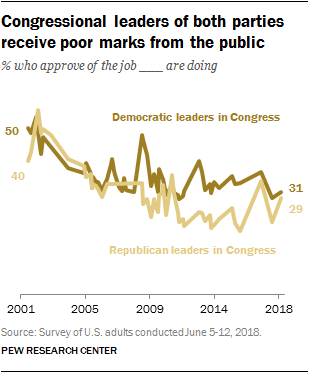
On balance, the public disapproves of the job congressional leaders of both parties are doing. Overall, about three-in-ten say they approve of the job Democratic leaders are doing (31%), while a very similar share say they approve of the job Republican leaders in Congress are doing (29%).
Approval for Democratic leaders in Congress is little changed since October and remains lower than public views of the Democratic leadership in February 2017.
In contrast, approval ratings for Republican leaders have improved since October (from 22% in October to 29% today).
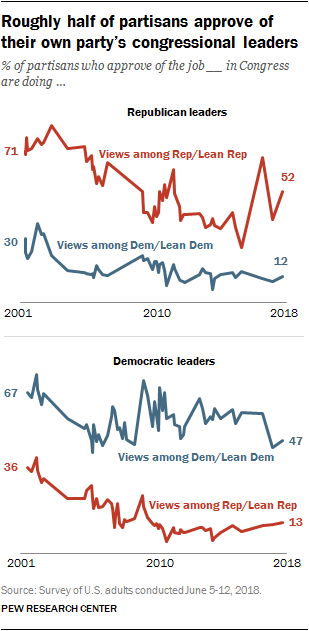
The recent improvement in Republican leaders’ approval ratings is attributable to warmer ratings from within their own party. In October, just 39% of Republicans and Republican leaners said they approved of their party’s leadership in Congress. Today, Republicans are more approving than disapproving: Just over half (52%) say they approve and four-in-ten say they disapprove.
Republicans’ ratings of their own party’s leadership have oscillated significantly over the past two decades, from a high of 83% in 2003 to just 26% in 2015.
On the other side of the aisle, Democrats’ views of their party’s congressional leadership are divided (47% approve, 43% disapprove). This is mostly unchanged since October and significantly lower than Democratic assessments of Democratic leaders in the five years prior.
Both Republicans and Democrats give poor ratings to congressional leaders of the opposing party. Today, only about one-in-ten give the other party’s leaders satisfactory marks.
More see immigration as most important national problem
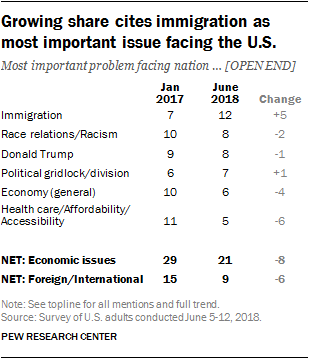
When asked in an open-ended format about the most important problem facing the country today, a growing share of the public cites immigration as its top concern. Overall, 12% volunteer immigration as the country’s most important problem, the most-cited issue in the survey. Mentions of immigration are up from January 2017, when 7% said this was the country’s top problem.
Race relations and racism (8%), and mentions of Donald Trump (8%), also rank near the top of the public’s most important problem list. Public views of the importance of these two issues are similar to the days immediately preceding Trump’s inauguration.
The shares who cite the economy or unemployment as the country’s top problems are both down from the start of 2017. In addition, fewer cite health care as the nation’s biggest problem today than did so in January 2017.
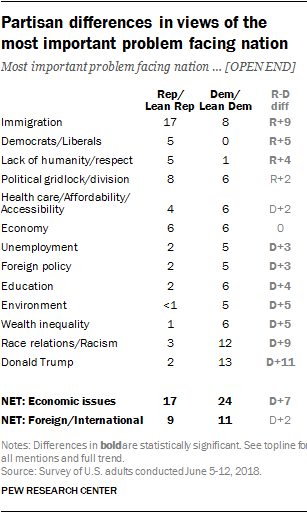
There are significant differences between how Republicans and Democrats view the most important problems facing the nation.
Immigration is far and away the top problem cited by Republicans and Republican leaners: 17% say this, compared with fewer than 10% who cite any other issue.
Political gridlock and division is the second most-mentioned issue for Republicans: 8% volunteer that this is the most important problem facing the nation. Another 5% say Democrats or liberals are the country’s biggest problem.
Among Democrats and Democratic leaners, Donald Trump (13%) and race relations and racism (12%) are cited most frequently as the nation’s top problem; 8% of Democrats say immigration is the country’s most important problem.